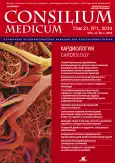Comparison of antiarrhythmic medications propafenone and amiodarone injection forms effectiveness in medicamentous cardioversion of paroxysmal atrial fibrillation
- Authors: Tarasov A.V.1, Kosykh S.A.2, Bushueva E.V.3, Davtyan K.V.1, Miller O.N.4
-
Affiliations:
- National Medical Research Center for Preventive Medicine of the Ministry of Health of the Russian Federation
- Moscow Regional Ambulance Station
- L.A.Vorokhobov City Clinical Hospital №67
- Novosibirsk State Medical University of the Ministry of Health of the Russian Federation
- Issue: Vol 21, No 1 (2019)
- Pages: 81-86
- Section: Articles
- URL: https://journals.rcsi.science/2075-1753/article/view/96902
- DOI: https://doi.org/10.26442/20751753.2019.1.190286
- ID: 96902
Cite item
Full Text
Abstract
Full Text
##article.viewOnOriginalSite##About the authors
Aleksei V. Tarasov
National Medical Research Center for Preventive Medicine of the Ministry of Health of the Russian Federation
Email: a730tv@yandex.ru
Cand. Sci. (Med.), Head of Department of Surgery of Complex Cardiac Rhythm Disturbances and Cardiac Pacemaker Implantation 10, 3, Petroverigskii ln., Moscow, 101990, Russian Federation
Sergei A. Kosykh
Moscow Regional Ambulance StationHead of Puskin station of North-East district State Budgetary Healthcare Institution, Chief external expert on EMC at medical district №1 of Moscow region Ministry of Health, emergency physician, first category intensivist 3, Znamenskaia st., Krasnogorsk, Moscow region, 143405, Russian Federation
Elena V. Bushueva
L.A.Vorokhobov City Clinical Hospital №67Head of the 3rd Cardiological Department 2/44, Saliama Adilia st., Moscow, 123423, Russian Federation
Karapet V. Davtyan
National Medical Research Center for Preventive Medicine of the Ministry of Health of the Russian FederationD. Sci. (Med.), Head of Department of Arrythmias and Impairment of Heart Conduction 10, 3, Petroverigskii ln., Moscow, 101990, Russian Federation
Olga N. Miller
Novosibirsk State Medical University of the Ministry of Health of the Russian Federation
Email: miller.olga@list.ru
D. Sci. (Med.), Prof. at Department of Emergency Medicine, Endocrinology and Industrial Pathology 52, Krasnyi dr., Novosibirsk, 630091, Russian Federation
References
- Kirchhof P, Benussi S, Kotecha D et al. 2016 Esc Guidelines for the management of atrial fibrillation developed in collaboration with EACTS. The Task Force for the management of atrial fibrillation of the ESC. Developed with the special contribution of the EHRA of the ESC. Endorsed by the ESO. Eur Heart J 2016; 37 (38). doi: 10.1093/eurheartj/ehw210
- Диагностика и лечение фибрилляции предсердий. Рекомендации РКО и ВНОА, 2017.
- Goette А, Honeycutt С, Langberg J.J. Electrical remodelling in atrial fibrillation. Circulation 1996; 94 (7): 2968-74.
- Sra J, Zaidi S.T, Krum D et al. Correlation of spontaneous and induced premature atrial complexes initiating atrial fibrillation in humans: electrophysiologic parameters for guiding therapy. J Cardiovasc Electrophysiol 2001; 12 (12): 1347-52.
- Khan I.A. Single oral loading dose of propafenonefor pharmacological cardioversion of recent onset atrial fibrillation. J Am Coll Cardiol 2001; 37: 542-7.
- Boriani G, Martignani C, Biffi M et al. Oral loading with propafenone for oral conversion of recent-onset atrial fibrillation. A review of in-hospital treatment. Drugs 2002; 62: 415-23.
- Naccarelli G.V, Walbrette D.L, Khan M et al. Old and new antiarrhythmic drugs for converting and maintaining sinus rhythm in atrial fibrillation. Comparative efficacy and results of trials. Am J Cardiol 2003; 91 (Suppl.):15D-26D.
- Conti A, Del Taglia B, Mariannini Y et al. Management of patients with acute atrial fibrillation in the ED. Am J Emerg Med 2010; 28: 903-10.
- Sestito A, Molina E. Atrial fibrillation and the pharmacological treatment: the role of propafenone. Eur Rev Med Pharmacol Sci 2012; 16 (2): 242-53.
- Миллер О.Н., Тарасов А.В., Дик И.С., Беляева И.Е. Купирование фибрилляции предсердий на догоспитальном и стационарном этапах с позиций доказательной медицины. Consilium Medicum 2016; 18 (10): 8-18.
- Тарасов А.В. Вопросы безопасности антиаритмической терапии. Consilium Medicum. 2014;16 (10): 44-9.
Supplementary files






